Alaska Fish & Wildlife News
December 2015
Marten Trapping in Southeast Alaska
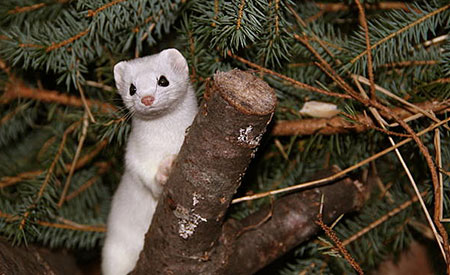
I grew up trapping muskrat in western New York state in the small rural community of Bolivar. I learned to trap from school mates, setting #110 conibears in a swamp near town. The first swamp I trapped was owned by a lady and her husband. I'd bought ice cream bars at the little grocery store where the lady worked. Her husband tended the down markers for our football games. Asking was a formality. Of course they'd give me permission to trap there. They'd known me all my life. I'd get up each morning and ride to the swamp and then pull and stretch the pelts after school. At $7.00 each, this was the heyday for muskrat prices. Good money for a kid on a bike.
I moved to Fairbanks in my late teens to attend the University of Alaska, and never got back to trapping until a few years ago when I went marten trapping with my brother-in-law and his family on Prince of Wales Island and caught the trapping bug again.? After helping him get his line out, I returned to Juneau and set a few marten traps of my own.
In the northern parts of Alaska, trapping is largely done by snow machine, and snow levels dictate trapping access and options. Too little snow and it may be impossible to get to your trapline. Too much, and your traps are buried. But the snow is particularly good for one thing: if there are furbearers around, they'll leave tracks.
Trapping in much of Southeast Alaska is regulated by two things: tide and wind. We have average tides of 15 feet or more near Juneau. I’ve learned the hard way to pay attention to the tide. My first year trapping, I returned from checking sets in what seemed like 20 minutes and found my boat high and dry on a falling tide. I can't move my aluminum boat off the beach once it's dry. I spent the rest of the day and half the night waiting for the tide to come back in. I now try to check my traps on a rising tide. If I can't, I try to get someone to go along to idle the boat offshore while I check. A third option would be to anchor offshore and take a punt to shore, but that might take more time than there are hours in the day in January. Wind is the other issue. The prevailing wind here is from the southeast. I try to set my traps near a creek where I can anchor the boat in the lee of a point.The creek mouth makes a good visual aid to find my sets from the boat and the creeks tend to be corridors along which marten and mink travel. We don't always have snow during trapping season here, so you can't always set based on the presence of tracks. I set my traps just inside the woods from the beach fringe so I can keep an eye on the boat.
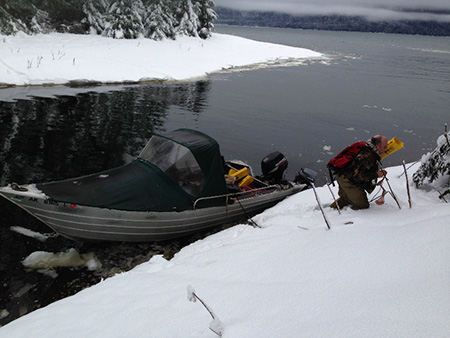
I trap as my brother-in-law taught me. I use #120 conibear traps set in a box (I use newspaper tubes) that are hung vertically on a tree about chest height or horizontally on a deadfall. Bait is placed in the back of the box, with a trap in front. The marten climbs up the tree and through the trap to get to the bait. The ADF&G website offers a thorough description of trapping marten using newspaper tubes.
I used to make one or two box sets per location, but now many times I set three. Winter weather can be very unpredictable. Each time I set my traps, I may have to pull them on the next check because the weather forecast may be unsafe for boating for another week. By setting several traps at each site, I maximize harvest during the periods when the weather allows me to be active, and a double catch is not uncommon. I have little worry about over harvesting marten in my trapping area with multiple sets per location. This might be an issue in areas up north, where there is virtually unlimited access via snow machine. Or in other parts of Southeast Alaska, where logging roads provide vehicle access to an expanded areas. The places I trap are only accessible by boat. There are no roads or reliable access by snow machine, so no one would be trapping inland from my beach sets. Untouched marten populations from the middle of Admiralty Island would likely fill any void left by my harvest on the beach.
When butchering deer, I save scraps of deer fat, bloodshot meat and the leg bones to use on the trapline. I put the deer scraps in a bait jar in the back of the newspaper tube, with a blob of strawberry jam on the bait jar. For a scent attractor, I use marten lure on a nearby branch. For a visual attractor, I hang a deer bone or piece of surveyor tape from a branch to dance in the breeze. The attractors are used to get the martens attention to get it close enough to smell the bait.
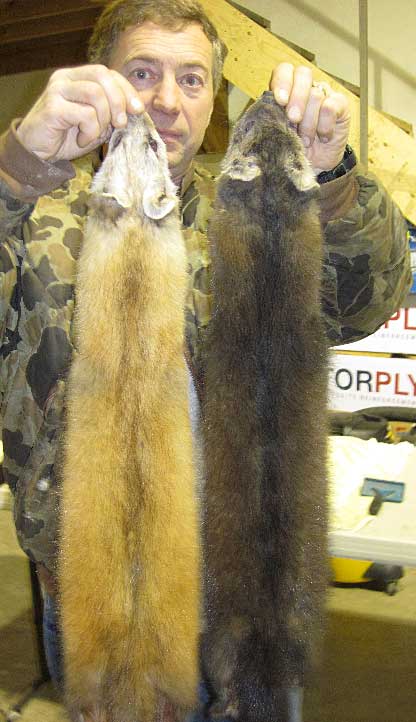
To avoid damage to the pelt from pine pitch in the fur, I try to set the trap so a marten will hang away from the tree. I prefer to set on an alder tree to avoid pitch altogether. Hanging marten sets also keep rodents from damaging the pelt.
The marten I harvest are primarily the Pacific marten (Martes caurina), which are endemic to Admiralty and Kuiu Islands in Southeast Alaska. The marten tend to be yellowish-orange in color, and not the dark brown of the American marten (Martes americana) found on the mainland and other islands in Southeast Alaska.
Marten trapping season opens here Dec. 1, so it overlaps for a month with deer hunting season. I carry my deer rifle with me to each set during December. After setting my trap, I walk a short ways into the woods and blow my deer call. I lucked out with a small buck on the last day of deer season in 2012. I easily dragged the deer the short distance downhill in the snow and dressed it right near the beach. The gut pile served as a bonus attractor for the traps I'd just set.
After deer season closes Dec. 31, I rarely see anyone else out on the water through the end of trapping season in mid-February. Occasionally, there's a tug and barge, a commercial fishing boat, or a skiff fisherman trying for a winter king salmon. I usually have the whole waterway to myself. The solitude is one of the reasons I trap but also requires heightened caution as there's no help nearby.My skiff has a little canvas shelter. I always have enough gear to spend the night if necessary, including a sleeping bag and single burner stove to keep me warm and dry. I also have a VHF radio, since cell phone coverage is not comprehensive here.
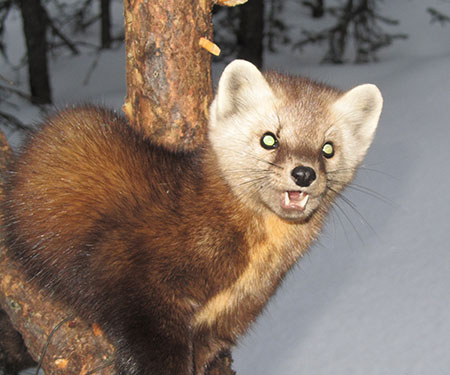
My first year, I had the hides from the few marten I caught tanned and made into a hat by a fur sewer on the Kenai Peninsula. The hat keeps my head and face warm traveling in the skiff in the winter wind. I later took a fur sewing class at a "Becoming an Outdoors Woman" workshop (men are allowed!) offered by ADF&G, and made a couple hats that I gave as gifts.
Although they are one of the smaller fur bearers in Alaska, marten are one of the most valuable. In some years, they command prices over $100 each for prime pelts. The yellow-orange Pacific marten usually bring in somewhat less as fur buyers like the all-brown marten better for some reason. Marten are among the easiest of pelts to handle for the beginning trapper. River otter and mink - and less commonly, beaver - are usually found in the same general areas as marten in Southeast Alaska. Mink are similar in size to marten, with similar pelt preparation. Otter and beaver yield much larger pelts, but require much more labor and time to prepare the pelts. What may be surprising to non-trappers is that beaver, otter and mink usually bring lower prices than the marten.
We have few fur buyers in Southeast Alaska. Many trappers sell their fur through one of the auction houses back east. These auction houses have representatives in Alaska's Railbelt towns. Trappers can send their furs to these fur consolidators, who then send the furs east in a large shipment. Other Southeast Alaska trappers get their tides tanned to make their own wares, or sell hides to local fur sewers.
Other parts of fur bearers are also used. Some fur bearers are edible, with lynx, muskrat and beaver commonly eaten. Muskrat and beaver meat are used as trapping bait, too. Furbearer teeth are used for jewelry. Skulls can be cleaned and sold. I've not heard of anyone eating marten. Other trappers tell me marten meat is not good trapping bait, either, so I guess they must not taste very good.
The Alaska Trapper Association has good resources for the beginning trapper. ATA issues a magazine over the winter months with articles on how people trap around the state. Trapping techniques are just a little bit different in the various parts of the state, so it's interesting to read how others trap. ATA also has books and videos on trapping and fur care, and offers classes on trapping and cabin building. Another helpful site is trapperman.com, with trappers from all over the northern climes sharing their experiences.
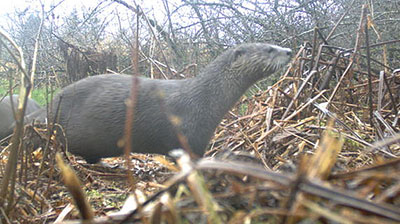
For some good Alaska trapping tales, try "The Cheechakoes" by Wayne Short (Southeast Alaska), "Shadows on the Koyukuk: An Alaskan Native's Life along the River" by Sidney Huntington and Jim Reardon, "Blue Hills" by Judy Ferguson (Delta area), "Staying Alive in Alaska's Wild" by Andrew Nault (Kodiak/Kamishak Bay area), "Trapline Twins" by Julie and Miki Collins (Lake Minchumina area), and "Alaska Tracks" by Randy Zarnke (statewide trapper biographies). "Dangerous River" by R.M. Patterson is another great story about trapping and gold prospecting in the Northwest Territory near the Yukon Territory border in the 1920's.
ADF&G research on marten from around the state can be found on the department's Wildlife Publications website.
More on Pacific marten (Martes caurina), and American marten (Martes americana)
The ADF&G website offers more on trapping, including the trapper reports (known as the Trapper Questionairre) which details fur prices, harvest in various parts of the state, and comments by Alaska trappers.
Mark Stopha is a fishery biologist in Juneau.
Subscribe to be notified about new issues
Receive a monthly notice about new issues and articles.
